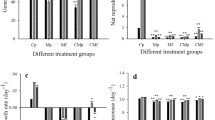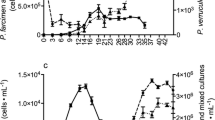Abstract
Food selectivity was examined in amictic female rotifers, Brachionus plicatilis, fed Chlamydomonas sp. and Olisthodiscus sp. Filtering and ingestion rates of the rotifers in a single food suspension were higher with Chlamydomonas sp. than with Olisthodiscus sp. In every mixture of two food species, the apparent filtering rate on Chlamydomonas sp. was much higher than that on Olisthodiscus sp. Total filtering rate and apparent filtering rate in food suspensions containing Chlamydomonas sp. decreased with increasing cell concentration of Chlamydomonas sp. Total and apparent filtering rates were calculated from the decrease in total food concentration as well as from decreases in concentrations of each of the two food algae, respectively. B. plicatilis ingested Olisthodiscus sp. at an extremely low constant rate in all mixtures. The degree of food selectivity of the rotifers fed Chlamydomonas sp. (i.e., selective filtration) from the mixture of two food algae decreased with increasing cell concentration of Chlamydomonas sp. Filtering and ingestion rates of rotifers fed senescent Chlamydomonas sp. were relatively lower than those fed Chlamydomonas sp. in the exponential phase. This indicates that Brachionus plicatilis displays selectivity in regard to condition of cells as well as type of food.
Similar content being viewed by others
Literature Cited
Berman, M.R. and S. Richman: The feeding behavior of Daphnia pulex from lake Winnebago, Wisconsin. Limnol. Oceanogr. 19, 105–109 (1974)
Dochan, M.: An energy budget for adult Brachionus plicatilis Muller (Rotatoria). Oecologia (Berl.) 13, 351–362 (1973)
Edmondson, W.T. and G.G. Winberg (Ed.): A manual on methods for the assessment of secondary productivity in fresh waters, 358 pp. Oxford & Edinburgh: Blackwell Scientific Publications 1971. (IBP Handbook, No. 17)
Furukawa, I. and K. Hidaka: Technical problems encountered in the mass culture of the rotifer using marine yeast as food organisms. Bull. Plankton Soc. Japan 20, 61–71 (1974)
Gaudy, R.: Feeding four species of pelagic copepods under experimental conditions. Mar. Biol. 25, 125–141 (1974)
Gauld, D.T.: The grazing rate of planktonic copepods. J. mar. biol. Ass. U.K. 26, 695–706 (1951)
Hargrave, B.T. and G.H. Geen: Effects of copepod grazing on two natural phytoplankton populations. J. Fish. Res. Bd Can. 27, 1395–1403 (1970)
Hirata, H. and Y. Mori: Mass-culture of the marine rotifer, Brachionus plicatilis, fed the bread yeast. [In Japanese]. Saibai-gyogyo 5, 36–40 (1967)
Hirayama, K. and T. Kusano: Fundamental studies on physiology of rotifer for its mass culture-II. Influence of water temperature on population growth of rotifer. Bull. Jap. Soc. scient. Fish. 38, 1357–1363 (1972)
— and S. Ogawa: Fundamental studies on physiology of rotifer for its mass culture-I. Filter feeding of rotifer. Bull. Jap. Soc. scient. Fish. 38, 1207–1214 (1972)
— and K. Watanabe: Fundamental studies on physiology of rotifer for its mass culture-IV. Nutritional effect of yeast on population growth of rotifer. Bull. Jap. Soc. scient. Fish. 39, 1129–1133 (1973)
——: Fundamental studies on physiology of rotifer for its mass culture-III. Influence of phytoplankton density on population growth. Bull. Jap. Soc. scient. Fish. 39, 1123–1127 (1973)
King, C.: Food, age, and the dynamics of a laboratory population of rotifers. Ecology 48, 111–128 (1967)
Marshall, S.M. and A.P. Orr: On the biology of Calanus finmarchicus-VIII. Food uptake, assimilation and excretion in adult and stage V Calanus. J. mar. biol. Ass. U.K. 34, 495–529 (1955)
McMahon, J.W. and F.H. Ringler: Feeding rate of Daphnia magna Straus in different food labeled with radioactive phosphorus. Limnol. Oceanogr. 10, 105–113 (1965)
Mullin, M.M.: Some factors affecting the feeding of marine copepods of the genus Calanus. Limnol. Oceanogr. 8, 239–250 (1963)
Reeve, M.R.: The filter-feeding of Artemia-II. In suspensions of various particles. J. exp. Biol. 40, 207–214 (1963)
Richman, S. and J.N. Rogers: The feeding of Calanus helgolandicus on synchronously growing populations of the marine diatom Ditylum brightwelli. Limnol. Oceanogr. 14, 701–709 (1969)
Ryther, J.H.: Inhibitory effects of phytoplankton upon the feeding of Daphnia magna with reference to growth, reproduction and survival. Ecology 35, 522–533 (1954)
Theilacker, G.H. and M.F. McMaster: Mass culture of the rotifer Brachionus plicatilis and its evaluation as a food for larval anchovies. Mar. Biol. 10, 183–188 (1971)
Wilson, D.S.: Food size selection among copepods. Ecology 54, 909–914 (1973)
Author information
Authors and Affiliations
Additional information
Communicated by M. Anraku, Nagasaki
Rights and permissions
About this article
Cite this article
Chotiyaputta, C., Hirayama, K. Food selectivity of the rotifer Brachionus plicatilis feeding on phytoplankton. Mar. Biol. 45, 105–111 (1978). https://doi.org/10.1007/BF00390546
Accepted:
Published:
Issue Date:
DOI: https://doi.org/10.1007/BF00390546




